
The Bates Building is a historic house in the Columbia-Tusculum neighborhood of Cincinnati, Ohio, United States. A two-story building constructed in a vernacular style of architecture, it is one of the oldest buildings on Eastern Avenue in the neighborhood.
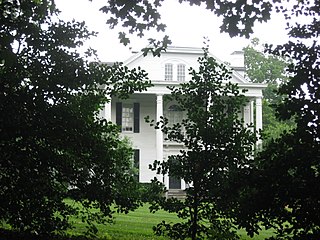
The August Bepler House is a historic residence in the city of Cincinnati, Ohio, United States. Located along Tusculum Avenue in that city's Columbia-Tusculum neighborhood, the house was built in 1869 for a wealthy inventor and industrialist, and it has been named a historic site.

The Stephen Decker Rowhouse is a historic multiple residence in the Columbia-Tusculum neighborhood of Cincinnati, Ohio, United States. Built in 1889, it occupies land that was originally a portion of the wide vineyards of Nicholas Longworth. In 1869, after his death, Longworth's estate was platted and sold to builders who constructed a residential neighborhood along Tusculum Avenue. One of the most unusual buildings was the Decker rowhouse, which features multiple distinctive Victorian elements. Chief among these is the ornamentation on the porch roofs: they include gabled rooflines and beveled corners supported by multiple spindles. Connecting these porch roofs are low normal roofs, which primarily protect the recessed entrances to the houses. Elsewhere, the houses feature double-hung windows, imbricated shingles on the gables, and arcades of Gothic Revival panelling, and numerous ornamental circles inscribed within squares. Taken as a single building, the rowhouse measures two bays wide and eighteen bays long; it is of frame construction and two stories tall. Rated "outstanding" by an architectural survey in 1978, it is the only rowhouse of its type in Cincinnati, due to its well-preserved Victorian architecture.

The Hoodin Building was a historic apartment building in the Columbia-Tusculum neighborhood of Cincinnati, Ohio, United States. Built in 1881, it was once one of the neighborhood's most prestigious addresses. Despite its designation as a historic site, it is no longer standing.

The Kestler Building was one of many historic buildings in the Columbia-Tusculum neighborhood of Cincinnati, Ohio, United States. Originally a store, it was a weatherboarded building set on a stone foundation. Parts of the building were once used for residential purposes, in addition to the commercial space. Along with many other buildings in the neighborhood, it was listed on the National Register of Historic Places on August 24, 1979, qualifying because of its historically significant architecture; like several other Eastern Avenue commercial buildings, it was deemed historic partially because of its exterior design work.
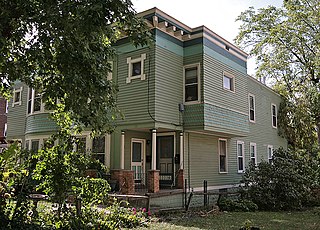
The Landt Building is a historic house in the Columbia-Tusculum neighborhood of Cincinnati, Ohio, United States. Constructed at the end of the nineteenth century, it has been named one of the neighborhood's numerous historic sites.
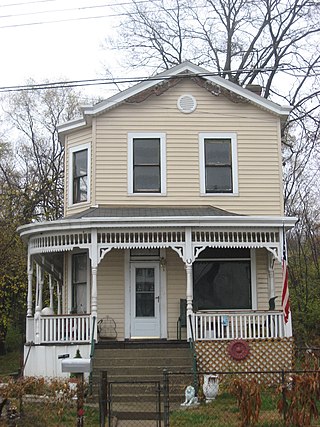
The LuNeack House is a historic residence in the Columbia-Tusculum neighborhood of Cincinnati, Ohio, United States. Built in 1894, it is a frame building with clapboard walls, two-and-a-half stories tall. The overall floor plan of the house is that of a rectangle, with the front and rear being the shorter sides, although the original shape has been modified by the extension of the rear and a hexagonal bay on the western side.

The Mardot Antique Shop was a historic commercial building in the Columbia-Tusculum neighborhood of Cincinnati, Ohio, United States. Built in 1889, it was a weatherboarded structure with a slate roof and built on a stone foundation. Three stories tall, the building was a simple rectangle, two bays by three, and it featured a simple symmetrical facade with a cast iron front and many windows. Other architectural features included multiple dormers in the roof, a small cornice with brackets, and a recessed portion of the storefront surrounding the main entrance.

The Norwell Residence is a historic house in the Columbia-Tusculum neighborhood of Cincinnati, Ohio, United States. A Victorian building constructed in 1890, it is a weatherboarded structure with a stone foundation and a shingled roof. The overall floor plan of the house is irregular: two and half stories tall, the house is shaped like the letter "L" but appears to be a rectangle, due to the presence of two separate porches that fill in the remaining area. Many ornate details characterize it, including imbricated shingles on the westward-facing gable end of the house, a frieze with spindles on the railing of the primary porch, and small yet cunningly crafted braces for the same porch. Yet more distinctive is the secondary porch, which sits atop the primary one; it features braces and spindles similar to those of the primary porch.

The W.C. Retszch House is a historic residence in the city of Wyoming, Ohio, United States. Built at the opening of the late nineteenth century, it was originally the home of a Cincinnati-area businessman, and it has been designated a historic site because of its distinctive architecture.

The L.B. Robb Drugstore was a historic pharmacy in the Columbia-Tusculum neighborhood of Cincinnati, Ohio, United States. Erected in 1860, it was a four-story building, constructed of brick on a stone foundation and topped with a slate roof. The building was a simple rectangle in its floor plan, although not without embellishments: the roof, which rose to gables on the sides, was crowned by a large central chimney, while the gables were ornamented with machicolations, and the walls were anchored by brick pilasters. After the drugstore was completed, it was modified by the addition of a wooden porch to one of the sides; aside from the porch, it measured four bays on the front, four on the rear, and four on each side. The windows were of plain lintel construction with lugsills on the sides.
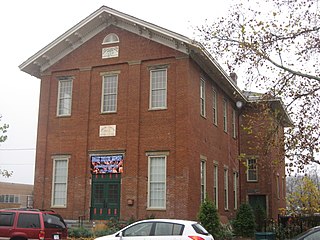
The Spencer Township Hall is a historic former government building in the Columbia-Tusculum neighborhood of Cincinnati, Ohio, United States. One of Cincinnati's oldest extant public buildings, it has been designated a historic site because of its architecture.

The Stites House is a historic residence in the Columbia-Tusculum neighborhood of Cincinnati, Ohio.
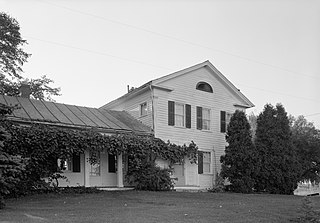
The Darlon Allen House is a historic residence located near Wellington in southern Lorain County, Ohio, United States. One of the most significant farmhouses in an area known for its historically important architecture, it has been named a historic site.

Carlos Avery House is a historic house in the Pittsfield Township, Ohio.

The Pioneer Memorial Cemetery is a historic pioneer cemetery in the Columbia-Tusculum neighborhood of Cincinnati, Ohio, United States. It is located on a small hill overlooking Lunken Airport at 333 Wilmer Avenue on Cincinnati's east side.

Applethorpe Farm is a historic farmstead in northeastern Ross County, Ohio, United States. Located along Whissler Road north of the unincorporated community of Hallsville, it was established by the family of John Buchwalter in the early years of the nineteenth century. Among the region's earliest settlers, the Buchwalters erected a large log building soon after taking possession of the property. As the years passed, the farm acquired the name of "Applethorpe" because its grounds included the first apple orchard in Ross County.
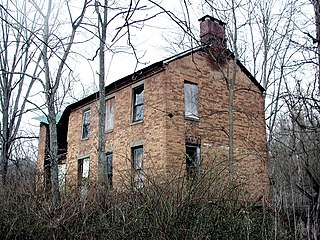
The Savage-Stewart House is one of the oldest buildings in Athens County, Ohio, United States. Located a short distance southeast of Canaanville along U.S. Route 50, it features many architectural details typical of expensive buildings constructed in early Ohio, and it has been named a historic site.

Lawler's Tavern is a historic commercial building in the village of Mechanicsburg, Ohio, United States. Built in 1830, it is one of the oldest buildings in the community, and it has been named a historic site.






















